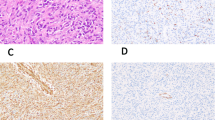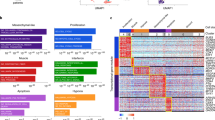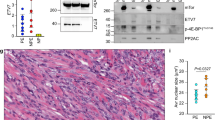Abstract
A new human embryonal rhabdomyosarcoma cell line, designated JR-1, is described that closely resembles the tumour from which it was derived. Comparative studies, by light and electron microscopy reveal morphological features such as myofibre formation, that are concordant with embryonal rhabdomyosarcoma. Immunohistological investigations using a panel of monoclonal antibodies indicate that the cell surface antigen profile of the JR-1 cell line is similar to other embryonal rhabdomyosarcomas. In addition the cell line expresses the cytoplasmic intermediate filament protein desmin, only found in cells of rhabdoid origin. Karyotyping JR-1 shows the cells to contain variable numbers of chromosomes (range 44-100). DNA flow cytometry indicates that cells have an DNA content which is approximately twice normal. The JR-1 cell line has a doubling time of 29 h in culture and, in common with several other human cell lines, produces xenografts in nude mice within 6 weeks of inoculation. With detailed studies on the original tumour and the JR-1 cell line, the latter should prove an excellent model system for investigating the biology of rhabdomyosarcoma.
This is a preview of subscription content, access via your institution
Access options
Subscribe to this journal
Receive 24 print issues and online access
$259.00 per year
only $10.79 per issue
Buy this article
- Purchase on Springer Link
- Instant access to full article PDF
Prices may be subject to local taxes which are calculated during checkout
Similar content being viewed by others
Rights and permissions
About this article
Cite this article
Clayton, J., Pincott, J., van den Berghe, J. et al. Comparative studies between a new human rhabdomyosarcoma cell line, JR-1 and its tumour of origin. Br J Cancer 54, 83–90 (1986). https://doi.org/10.1038/bjc.1986.155
Issue Date:
DOI: https://doi.org/10.1038/bjc.1986.155
This article is cited by
-
Molecular characterization of non-polio enteroviruses isolated from children with acute flaccid paralysis in IRAN, 2015–2018
Virus Genes (2020)
-
Differential cooperation of oncogenes with p53 and Bax to induce apoptosis in rhabdomyosarcoma
Molecular Cancer (2006)
-
Neural cell adhesion molecule (NCAM) in normal and neoplastic human pituitary tissues: Analysis by immunohistochemistry and in situ hybridization
Endocrine Pathology (1992)
-
A monoclonal antibody (ERIC-1), raised against retinoblastoma, that recognizes the neural cell adhesion molecule (NCAM) expressed on brain and tumours arising from the neuroectoderm
Journal of Neuro-Oncology (1991)



